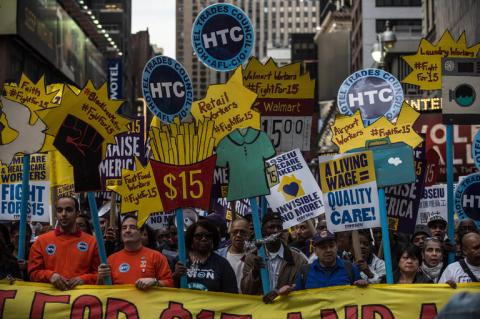Despite all the attention that has been paid to the union-backed campaign for a $15 minimum wage, the national decline in organized labor has persisted. Still, for three straight years, New York City, the birthplace of the Fight for $15 movement, has bucked that trend, according to a report that was to be released on Monday.
Nationally, fewer than one in nine workers is a union member, a share that has decreased slowly and steadily for more than 15 years, the report says. But in New York City, more than a quarter of workers are unionized, the highest proportion since 2007, according to the report.
“New York continues defying the law of gravity,” said Ruth Milkman, a co-author, with Stephanie Luce, of the annual report, titled “The State of the Unions.” Ms. Milkman and Ms. Luce are professors at the Murphy Institute for Worker Education and Labor Studies at the City University of New York.
The share of New York City workers who belong to unions has risen for three straight years — to 25.5 percent in the past year from 21.5 percent in 2012 — the report says. That is more than double the 10.9 percent of workers nationwide who are unionized. The report’s authors attribute the countertrend in New York to the rebound of traditionally unionized industries weakened by the recession, including construction and the hotel business.
And it has come about despite limited success in organizing the employees of fast-food restaurants and other workers who began the push for a $15 minimum wage, Ms. Milkman said.
When that campaign started in Manhattan in November 2012, its leaders called for two profound changes: an increase in the minimum wage to $15 an hour and union representation for the workers. At the time, neither demand seemed like anything more than a sky-blue delusion.
But with the help and financial backing of influential unions, the campaign won converts. In New York, Gov. Andrew M. Cuomo, a Democrat, at first balked at supporting the full wage demand. But he eventually embraced it and wound up racing Gov. Jerry Brown, a California Democrat, to sign legislation that would raise the state minimum wage to $15.
The minimum wage in California is scheduled to rise in steps to $15 by 2022. In New York City, the minimum wage will reach $15 by 2018; for the rest of the state, it will rise to at least $12.50 by 2021. Some cities outside those two states, including Seattle and Washington, have also adopted plans to raise their minimum wages to $15.
“The other places that have passed the $15-an-hour measure are also union strongholds,” Ms. Milkman said. So, she added, “there’s a decent possibility that this will lead to greater union membership.”
But there have also been periods of “fortress unionism” in American history, she said, when unions grew stronger in some cities and certain industries are “cemented by the political clout of organized labor,” while the labor movement declined nationally. It is easier to predict that employers will continue to “fight tooth and nail” against their employees’ attempts to organize, she said.
While New York City and the state have higher rates of union membership than any other city or state in the country, government employees account for most of that “density,” the report says.
About 70 percent of public-sector workers in the city and the state are union members, compared with just 19 percent of private-sector workers in the city and 13 percent in the rest of the state. Still, both of those rates are much higher than those of the nation, where less than 7 percent of private-sector workers — or about one in 15 — belong to unions.
All told, there are about 901,000 unionized workers living in New York City, slightly less than half the state’s total of 1.99 million. Only California has more — about 2.5 million in 2015, according to the federal Bureau of Labor Statistics. But that total amounted to only about one in six workers in California, compared with slightly less than one in four in New York State.


Spread the word